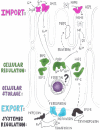Iron absorption in Drosophila melanogaster
- PMID: 23686013
- PMCID: PMC3708341
- DOI: 10.3390/nu5051622
Iron absorption in Drosophila melanogaster
Abstract
The way in which Drosophila melanogaster acquires iron from the diet remains poorly understood despite iron absorption being of vital significance for larval growth. To describe the process of organismal iron absorption, consideration needs to be given to cellular iron import, storage, export and how intestinal epithelial cells sense and respond to iron availability. Here we review studies on the Divalent Metal Transporter-1 homolog Malvolio (iron import), the recent discovery that Multicopper Oxidase-1 has ferroxidase activity (iron export) and the role of ferritin in the process of iron acquisition (iron storage). We also describe what is known about iron regulation in insect cells. We then draw upon knowledge from mammalian iron homeostasis to identify candidate genes in flies. Questions arise from the lack of conservation in Drosophila for key mammalian players, such as ferroportin, hepcidin and all the components of the hemochromatosis-related pathway. Drosophila and other insects also lack erythropoiesis. Thus, systemic iron regulation is likely to be conveyed by different signaling pathways and tissue requirements. The significance of regulating intestinal iron uptake is inferred from reports linking Drosophila developmental, immune, heat-shock and behavioral responses to iron sequestration.
Figures


Similar articles
-
Iron depletion in the intestines of Malvolio mutant flies does not occur in the absence of a multicopper oxidase.J Exp Biol. 2011 Mar 15;214(Pt 6):971-8. doi: 10.1242/jeb.051664. J Exp Biol. 2011. PMID: 21346125
-
Molecular physiology of iron trafficking in Drosophila melanogaster.Curr Opin Insect Sci. 2022 Apr;50:100888. doi: 10.1016/j.cois.2022.100888. Epub 2022 Feb 11. Curr Opin Insect Sci. 2022. PMID: 35158107 Review.
-
Immunolocalisation of the D. melanogaster Nramp homologue Malvolio to gut and Malpighian tubules provides evidence that Malvolio and Nramp2 are orthologous.J Exp Biol. 2006 May;209(Pt 10):1988-95. doi: 10.1242/jeb.02193. J Exp Biol. 2006. PMID: 16651563
-
Drosophila multicopper oxidase 3 is a potential ferroxidase involved in iron homeostasis.Biochim Biophys Acta Gen Subj. 2018 Aug;1862(8):1826-1834. doi: 10.1016/j.bbagen.2018.04.017. Epub 2018 Apr 21. Biochim Biophys Acta Gen Subj. 2018. PMID: 29684424
-
The ferroportin-ceruloplasmin system and the mammalian iron homeostasis machine: regulatory pathways and the role of lactoferrin.Biometals. 2018 Jun;31(3):399-414. doi: 10.1007/s10534-018-0087-5. Epub 2018 Feb 16. Biometals. 2018. PMID: 29453656 Review.
Cited by
-
Antennal transcriptome analysis reveals sensory receptors potentially associated with host detection in the livestock pest Lucilia cuprina.Parasit Vectors. 2024 Jul 18;17(1):308. doi: 10.1186/s13071-024-06391-6. Parasit Vectors. 2024. PMID: 39026238 Free PMC article.
-
Copper and Zinc Homeostasis: Lessons from Drosophila melanogaster.Front Genet. 2017 Dec 21;8:223. doi: 10.3389/fgene.2017.00223. eCollection 2017. Front Genet. 2017. PMID: 29312444 Free PMC article. Review.
-
In situ detection of ferric reductase activity in the intestinal lumen of an insect.J Biol Inorg Chem. 2024 Dec;29(7-8):773-784. doi: 10.1007/s00775-024-02080-y. Epub 2024 Dec 1. J Biol Inorg Chem. 2024. PMID: 39617837 Free PMC article.
-
Comparison of insect and human cytochrome b561 proteins: Insights into candidate ferric reductases in insects.PLoS One. 2023 Dec 1;18(12):e0291564. doi: 10.1371/journal.pone.0291564. eCollection 2023. PLoS One. 2023. PMID: 38039324 Free PMC article.
-
Ironing out the Details: Exploring the Role of Iron and Heme in Blood-Sucking Arthropods.Front Physiol. 2018 Jan 17;8:1134. doi: 10.3389/fphys.2017.01134. eCollection 2017. Front Physiol. 2018. PMID: 29387018 Free PMC article. Review.
References
-
- Missirlis F., Kosmidis S., Brody T., Mavrakis M., Holmberg S., Odenwald W.F., Skoulakis E.M., Rouault T.A. Homeostatic mechanisms for iron storage revealed by genetic manipulations and live imaging of Drosophila ferritin. Genetics. 2007;177:89–100. doi: 10.1534/genetics.107.075150. - DOI - PMC - PubMed
-
- Warburg O. Iron, the oxygen-carrier of respiration-ferment. Science. 1925;61:575–582. - PubMed
Publication types
MeSH terms
Substances
LinkOut - more resources
Full Text Sources
Other Literature Sources
Medical
Molecular Biology Databases

